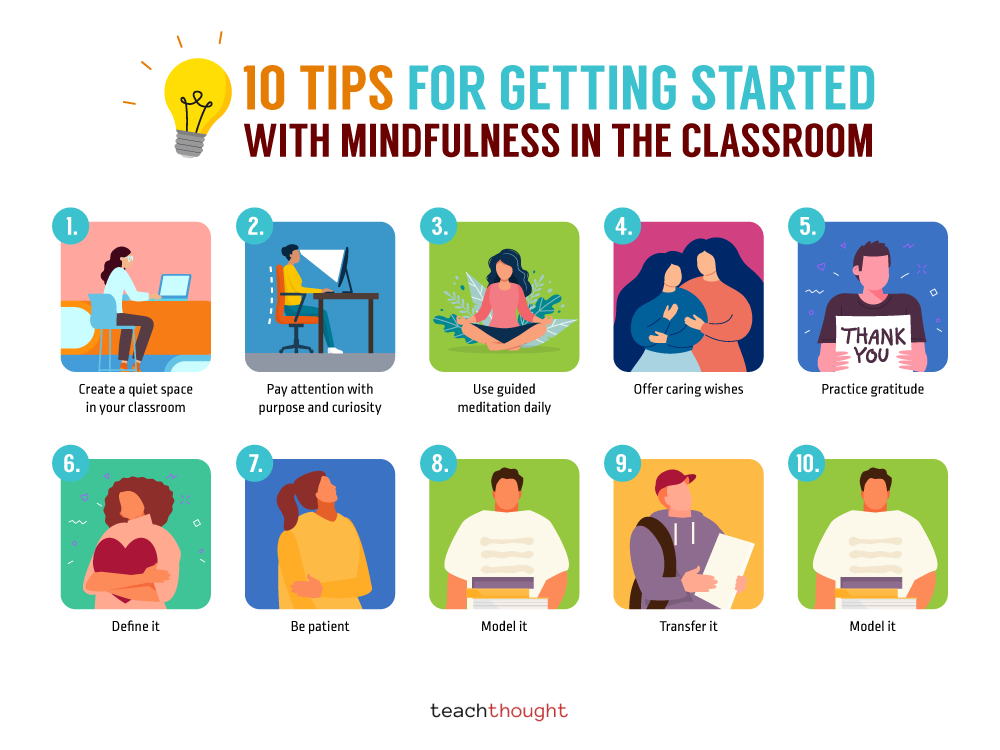

by Staff
While scientists at the University of Wisconsin-Madison Center for Investigation Healthy Minds (CIHM) at Waisman Center are not yet ready to issue mindfulness program founded Positive class atmosphere.
See also What are the school levels by age?
10 tips to start with mindfulness at school at any level
1. Create a quiet space in your class
Find a time and / or a place where you and your students can take a break for a few moments and develop a feeling of comfort with calm. Notice how we can become aware of things around us and in us in a new and different way.
This can work for you as a teacher when designing instructions or respond to students’ work, or to the spaces that students work themselves. If you are unable to create such a space for students, the use of white noise (Simplynoise.com, for example) can help hide background noise or always “hyperactive” minds. We even made our own mixture of background noise for reading and writingAlso.
2. Be careful with a goal and a curiosity
Ask students to notice sounds, textures, colors, shapes and other characteristics of their environment. (These can also be excellent writing prompts.)
As a teacher, if you are capable, try a conscious and slowly food exercise, with silent attention, explore a food with all the senses before eating it – noting odors, colors, textures and all the sensations of pleasure or dissatisfaction.
Being in the moment is both a cause and an effect of mindfulness. Mindfulness is rooted in the present. Reflections on yesterday, tomorrow, or even your “self” in the context of an afternoon or a school year or an activity are the opposite of the presence in the present.
3. Use guided meditation daily
With the students, explore the breath by making them close their eyes and explore a guided meditation every day before the course. Sam Harris’ Waking Up application could be useful here for older students while Moshi is useful for young students.
4. Offer attentive wishes
Train to take care and compassion for ourselves and others by offering wishes such as “that we are happy, that we are safe, that we are filled with love.” Could they laugh in August, but in May? They can just wish you affection right away.
Attentive wishes can be used when we experience discomfort before passing a test, when reading aloud, or simply sending another person kindness, knowing that we all want to be happy.
5. Practice gratitude
We can cultivate gratitude in a simple way; For example, we can take a few minutes to think about the good things that happened during the day, keep a list of people and things for which we are grateful and / or create a gratitude journal using words and images. Write on this subject, talk about it, think about it.
6. Keep things simple
Although mindfulness is advancing can be incredibly powerful, for the classroom, keeping it fun, simple and “centered on the child” (rather than “the practice of mindfulness”).
7. Be patient
These ideas will take patience to develop as students’ ability. Start small activities. Accept challenges as they arise. Help students contextualize what they do and why they do it. There is no reason for mindfulness to be able to succeed in any class K-12.
8. Moddle it – or let others do it
Look at the other “conscious” so that they can see what it looks like in different forms, contexts and applications. This can be done live, or via YouTube, or even videos that the students make themselves.
Many people do not understand mindfulness, Zen, meditation and other “mystical” practices which often just summarize the mind by losing the “self”.
9. Transfer
Help them to wear it beyond the classroom by offering advice, resources, ideas and even more to be aware of their daily life. (After all, isn’t it the point?)
10. Journal on this subject
What it is, what it is not, when it “worked”, when it was not, what were the advantages, what other aspects of the growth of daily consciousness could lead, etc.
Other tips for teaching full awareness of children at any level
11. You don’t have to make it “fun” but you cannot dry it. Make it “living” and vibrant because every moment is alive and vibrant.
12. Use a variety of “places” and “possibilities” for mindfulness: in class, outside, online, with open and closed eyes, before a test and after, with the lights on and off, etc.
Here are improved replacements for advice 13 and 14 that maintain the spirit of your original list but offer more practical strategies, adapted to age and class:
13. Normalize mindfulness by connecting it to the daily life of students.
Rather than relying on mentions of celebrities, show students how mindfulness can help them with real relatable challenges – like staying calm before a test, falls asleep more easily or manage conflicts with a classmate. Training it as a practical life skill increases adhesion and makes it less like a “school thing” and more like a “thing of life”.
14. Teach the brain connection – body in simple and visual terms.
Use an analogy that students can grasp, such as the brain comparison to a smartphone that needs loading and cleaning of memory. Explain how much mindfulness is like a “reset” button for their mind, improving concentration, emotional balance and even memory. Add a visual anchor, such as a quick sketch of a “battery counter” showing how stress drains energy and mindfulness restores it.
Teach mindfulness any note
Teachthought’s mission is to promote critical thinking and innovation education.



